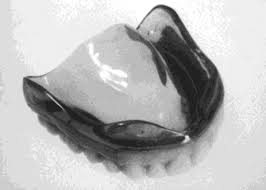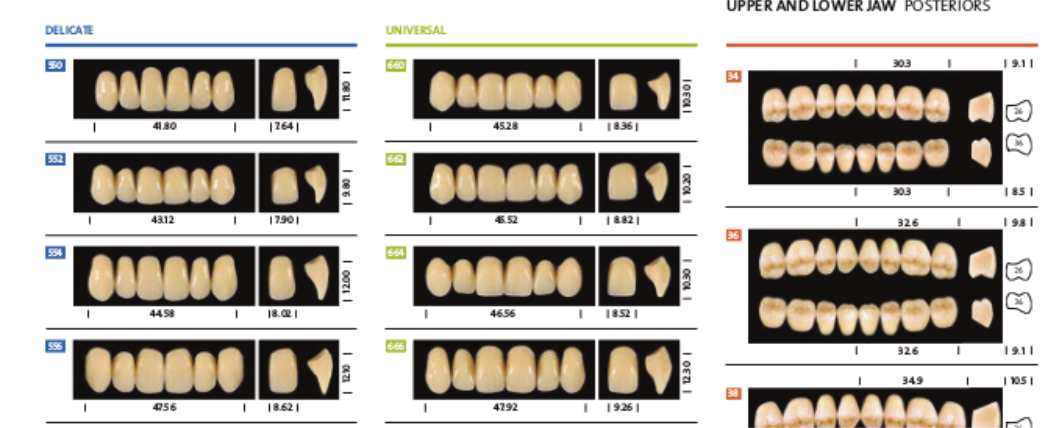|
The History Of Dentures – Time Line From 700 BCE Year 700 BC The first set of Dentures was made by Etruscan people living in Etruria (Umbria and Tuscany, Italy) from 700 BC onwards. Teeth was used from other humans or animals and was inserted and pinned together via a gold band with a metal pin and fitted onto the remaining teeth, this option was expensive and only for the wealthy. (Figure 1, 2 Copy of an Etruscan denture, Science Museum London) Year 1600 In the early 1600s: Japan invented the first set of functional complete dentures out of wood (Figure 2) but later versions introduced the use of ivory, animal horns sculpted to mimic natural teeth. Animal's such as the hippopotamus and elephant ivory was carved into dentures to imitate natural teeth. Over time, the ivory became stained and gave off a foul smell and were uncomfortable to wear. Full lower sets were weighted to help gravity. To help upper sets stay in place springs were attached to the bottom set and the spring thus pushed the upper set upwards. (Figure 3, 4 BDA Dental Museum) Year 1700 In the 1700's: John Hunter, attempted to transplant human teeth into a comb of a rooster. Studies showed this was unsuccessful although the tooth was firmly implanted in the rooster, it did not work for humans. Although it was considered unsuccessful it created principles for future implantation. Around the 1770s, Alexis Duchâtea created the first set of porcelain dentures. (Figure 5, source unknown) Year 1800 In the early 1800s: A major source of teeth was scavenged from dead soldiers in the battle fields of Europe following the Battle of Waterloo. In 1815, dentures was constructed with the teeth of the dead soldiers and was known as ‘Waterloo Teeth’ and fixed onto a ivory base. (Figure 8 -12 BDA Dental Museum) They would have been shaped and sorted to make it look like each set of upper and lower front teeth had come from a single body. The sets would have been sold to early dental technicians who would boil them, chop off the ends, and then shape them on to ivory dentures. (Figure 13, BDA Dental Museum) Year 1820 In 1820: English goldsmith and dental manufacturer Claudius Ash mounted porcelain on 18-karat gold plates, with gold springs and swivels. (Figure 14, unknown source) Year 1840 - 1850 In the 1840s - 1850s: The Goodyear family invented and developed a material that was used for the bases of dentures called Vulcanite. This material would replace the ivory in previous dentures with a hardened rubber material . The properties of Vulcanite allowed the material to be easily mouldable to a humans gums and harden without losing the shape of the gums. This was considered a cheaper option than gold denture bases which made dentures affordable for everyone. (Figure 15 - 19 BDA Dental Museum) Year 1851 In 1851: Edwin Truman used Gutta Percha material as a replacement for Vulcanite but later found the material was unstable and needed complicated equipment. (Figure 20, unknown source) Year 1868 In 1868:John Hayatt discovered a substitute material for Vulcanite called Celluloid, this was unsuccessful due to its absorption of stains, odours and the dentures colour changing to a black colour and being highly flammable as it used camphor as a plasticizer. (Figure 21, unknown source) Year 1901 In 1901: Dr. Otto Rohn prepared studies on a new material called poly methyl methacrylate. Year 1909 In 1909 Dr. Leo Bakeland discovered phenol-formaldehyde resin (bakelite) but was unsuccessful due its unstable dimensional properties and lack of uniformity, this was used in dentistry from 1924 and 1939. Year 1937 In 1937 Dr. Walter H Wright presented the studies of the use of poly methyl methacrylate resin as a denture base to the National Society of Denture Prosthetics in America. Year 1938 - present From 1938 polymethylmethacylite (PMMA or acrylic resin) became prevailing material for denture base and acrylic teeth. It is hard, translucent and inert (has no unpleasant odor or toxicity), it can be easily repaired and it is inexpensive. The acrylic teeth and denture base chemically and mechanically bond together to provide a stable denture with excellent properties. PMMA acrylic teeth are available variety of shades, shapes moulds to create a unique, realistic denture, which allow the ‘Dental Professional’ to create a functional, natural looking denture unique to the patient. (Figure 22, Metrodent, Candulor) PMMA denture base comes in a variety of shades to realistically match the pigment of the gingiva with high flexural strength properties (Figure 23, Diamond D, Keystone Industries). Click below for the next part: ' The History of NHS Dentistry'
0 Comments
Your comment will be posted after it is approved.
Leave a Reply. |
Private Dental Laboratory in London
 Kash Qureshi - Managing Director, Clinical Dental Technician Kash Qureshi - Managing Director, Clinical Dental Technician
About the author:
Kash Qureshi is a Clinical Dental Technician (Denturist) in the U.K who oversees and quality controls over 3000+ fixed and removable prosthesis including implant cases from a clinical and technical aspect monthly at Bremadent Dental Laboratory & Swissedent Denture Clinic in London. www.swissedent.co.uk www.bremadent.co.uk [email protected] Categories
All
Archives
May 2024
|

























 RSS Feed
RSS Feed